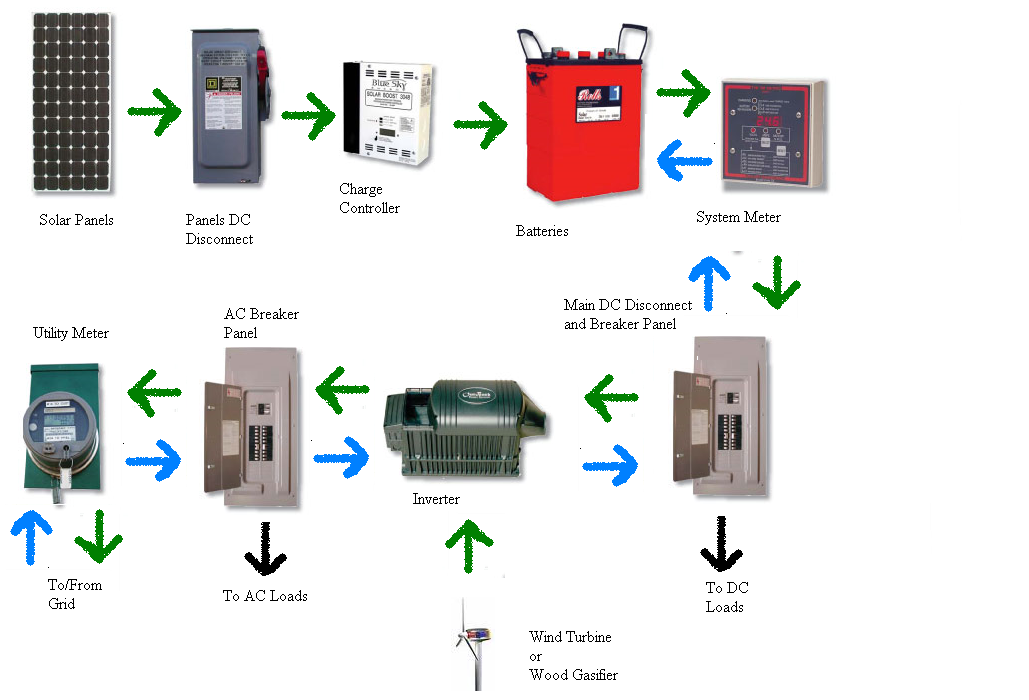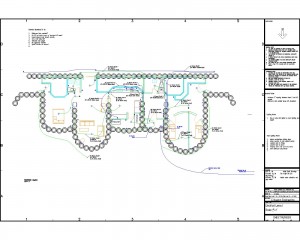
I have been struggling with what the electrical layout will look like for this building.
In very basic terms the above diagram sketches out the components of our proposed electrical system. Our intention is to generate our own electricity and sell any excess daily power back to BC Hydro. Hopefully, on an annual basis we will produce more power than we consume. BC Hydro does not offer any real incentive to produce your own electricity, the payback period on any system installed today is ridiculously long. However, Ontario now offers enough of an incentive to make such a system feasible, and I expect other provincial power authorities to follow suite as rates are inevitably increased. I view this as a philosophical decision. Centralized power distribution came about due to cheap and abundant energy, a resource constrained future will not support this energy infrastructure down the road. Besides, I would love to see my electric meter spin backwards!
I imagine that a lot of what I sketched above will change when we get to applying for our electrical permit and implementing our electrical plan. For now this sketch allowed me to generate the branch circuit layout below (also as a PDF Newton-electrical).
 Here again I suspect this layout will change, but it does give me what I need to layout enough rough-in wiring to get the roof of the building finished!
Here again I suspect this layout will change, but it does give me what I need to layout enough rough-in wiring to get the roof of the building finished!
Having finally done this exercise it is hard to feel that you can build sustainably given current code requirements. The electrical code requires a lot of circuits (multiple plug circuits for the kitchen counters for example) that seem excessive when you are trying to reduce your footprint. This kitchen plug-in requirement avoids having the power fail when you use the microwave to melt butter while you are beating eggs, but perhaps we should be evaluating the need to melt butter AND beat eggs at the same time.
Also, our decision to use DC lights means an increase in the number of circuits in the house. The simple reason for this is that low voltage DC lights and appliances draw more amperage, and thus are limited to the number of them that can be on one shared circuit. The reduced power consumption of these lights and appliances should more than compensate for the increased wiring.
At any rate I can now do the wiring necessary to carry on with the roof …
Hi, I saw your messages on Gord and Anne’s facebook page about electrical struggles. EA is here to help you with renewable energy systems if you need! This is what we do, and have been doing since 1984.
Looks good but in the kitchen I would look into the GFCI 20Amp receptacles. The new code requires GFCI with in 1 meter of a sink. This was a recent change (last code book). It does apply to bathrooms as well but they do not need to be 20 amp. The kitchen circuits then require #12 Awg wire to allow for that amp rating. You are allowed a max of 2 recps per circuit this way to make wiring easier they do not have to be alternating like the old split receptacles.
The bedrooms require Arc-fault breakers. It doesn’t matter for the wiring too much as your lighting and receptacles are all ready separate. Just keep that in mind when buying breakers.
You can put a switch wall plug anywhere you want as it is just a splicing issue. I would like to chat more about this. If you wish call me at 403-606-0363.
Work out as many of these things as you can because changes in an earthship look tough.
I love watching the progress.
Jeremiah
Jeremiah,
Thanks for the heads-up on the kitchen circuits. I have changed the plans to reflect two 12/2C branch circuits.
Chris
Looking into my electrical plans now as well. Planning to put up a large solar array on the roof to generate my own power, and also have some batteries for backup power. However….
Just like at your place in Canada, here in Holland it can get cloudy for a couple of days, which means less (or almost no) electricity from my PV panels.
The classical answer to this will be to put a ton of batteries somewhere in the house and charge them when sunlight is available, and use energy from then when sunlight is nowhere to be found. Personally I see a couple of drawbacks with this
– You’ll need a couple of massive batteries to supply your house with power for, let’s say, 3 days as a backup. This will cost you a lot of money.
– Batteries are not (yet) really friendly for the environment, in production and after end of life.
– Batteries won’t last forever, prolly about 10 to 15 years.
A possible solution for this is to use a grid-tied system. This means you’ll tie your solar panels to the public power grid. If you use more power than your panels provide, power from the grid is taken, is your panels produce more power than you use, power is given to the grid and your meter will spin backwards!
However, there are some stories floating around on the web that state that “Once the grid drops out, my grid -tie inverter cuts out as wll ”
This is true for some grid-tie inverters, because they should not deliver power to the grid when the grid has failed, to avoid maintenace workers from getting electocuted by your solar energy. There are however grit-tie inverters that use the grid when available, and automagically switch to battery power when the grid failes. In the mean time they charge the batteries when the grid is up. An all-in-one solution. So, be sure to get the inverter that suits your needs
Jasper,
Our current thinking is to grid-tie our system with BC Hydro using an inverter that will work both with and without the utility power available.
This allows us to minimize batteries and not worry about the complete system initially. We are building on a budget and want to build our system in stages.
Dear Matadora, Very good, good, good step to change your home eeitcrlc supply to cell, because in long run, cell is cheaper. First you have to consider Power need for your house, eg. 1200W, then you go to sellers and choose one with lowest price but best quality. After that you should assemble/attach your solar panel in place that gets most Sunlight, most probably in your roof. Attach them tightly, avoid burglar. Original solar cell current is DC. Current from solar cell placed first in several car batteries, so you could use eeitcrlcity in night either. After that if your home appliances use DC, you could directly connect your appliances to batteries. But if your appliances need AC, current should be converted first from DC to AC use DC to AC converter. Car battery used to have 12 Volt DC. So if you need 220VAC, after DC converted into AC, then passed through transformer to increase voltage. Thank you very much Matadora.